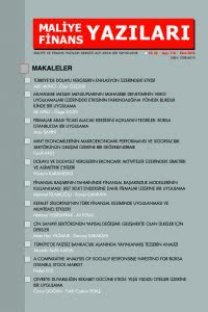Aşırı Büyüme Seviyelerinde Hissedar Değeri Yaratmak: Türkiye Örneği
Bu çalışmada, hızlı ve makul büyüme oranlarının hissedardeğeri yaratma hızlarını belirlemek amacıyla, Borsa İstanbul’daişlem gören finans sektörü dışında kalan 167 şirketin 8 yıllık malibilgileri panel veri analizinde kullanılmıştır. Sürdürülebilir büyümeoranı üzerindeki büyümenin sistematik olarak hissedar değeriniazaltıcı etki yarattığı belirlenmiştir. Ayrıca, toplam hissedar getirisinin,büyümenin içbükey (konkav) bir fonksiyonu olduğu, belirlenenoptimal noktanın üzerindeki satış büyümelerinin hissedardeğeri üzerinde azaltıcı etki yarattığı gösterilmiştir.
Anahtar Kelimeler:
Değer Yaratma, Firma Büyümesi, Sürdürülebilir Büyüme Oranı
Shareholder Value Creation at Excessive Growth Levels: Empirical Evidence from Turkey
In this study, to determine value creation rates at high andmoderate growth levels, 8 years data of 167 non-financial companiesof Borsa Istanbul is employed in a panel data analysis. Thestudy found that growing significantly above sustainable growthrate is systematically associated with value destruction. It is alsodemonstrated that shareholder return is a concave function of firmgrowth, proposing an optimal point of sales growth beyond whichfurther growth destroys shareholder value.
Keywords:
Value Creation Firm Growth, Sustainable Growth Rate, Sales growth,
___
- Amouzesh, N., Moeinfar, Z., and Mousavi, Z. 2011. Sustainable Growth Rate and Firm Performance: Evidence From Iran Stock Exchange. International Journal of Business and Social Science 2 (23): 249-255 Breusch, T. S., Pagan, A. R. 1980. The Lagrange multiplier test and its applications to model specification in econometrics. Review of Economic Studies 47 (1): 239– 253 Davidsson, P., Steffens, P., and Fitzsimmons, J. 2009. Growing Profitable of Growing from Profits: Putting the Horse in front of the Cart. Journal of Business Venturing 24: 388-406 Fuller, J., and Jensen, M. C. 2002. Just Say No to Wall Street: Courageous CEOs are putting a stop to the earnings game and we will all be better off for it. Journal of Applied Corporate Finance 14(4): 41-46 Hausman, J. A., and Taylor, W. E. 1981. Panel Data and Unobservable Individual Effects. Econometrics 49(6): 1377 – 1398 Higgins, R. C. 1977. How Much Growth Can a Firm Afford. Financial Management (Fall): 7-16 Higgins, R. C. 1981. Sustainable Growth under Inflation. Financial Management (Autumn): 36-40 Johnson, D. J. 1981. The Behavior of Financial Structure and Sustainable Growth in an Inflationary Environment. Financial Management (Autumn): 30-35 Kasznik, R., and McNichols, M. F. 2002. Does Meeting Earnings Expectations Matter? Evidence from Analyst Forecast Revisions and Share Prices. Journal of Accounting Research, 40 (3): 727-759 Lang, L., Ofek, E., and Stulz, R. M. 1996. Leverage, Investment and Firm Growth. Journal of Financial Economics 40: 3-29 Lintner, J. 1964. Optimal Dividends and Corporate Growth under Uncertainty. The Quarterly Journal of Economics. 78 (1): 49-95 Lockwood, L., and Prombutr, W. 2010. Sustainable Growth and Stock Returns. The Journal of Financial Research 33 (4): 519–538 Markman, G. D., and Gartner, W. B.. 2002. Is Extraordinary Growth Profitable? A Study of Inc. 500 High Growth Companies. Entrepreneurship Theory and Practice 27: 65-75 Myers, S. C., and Majluf, N. S. 1984. Corporate Financing and Investment Decisions When Firms Have Information Investors Do Not Have. Journal of Financial Economics 13: 187-221
- ISSN: 1308-6014
- Yayın Aralığı: Yılda 2 Sayı
- Başlangıç: 2008
- Yayıncı: Maliye ve Finans Yazıları Yayıncılık Ltd. Şti.
Sayıdaki Diğer Makaleler
Petrol Fiyatlarındaki Değişimlerin Türkiye’nin Cari İşlemler Açığına Etkileri
Selim GÜNGÖR, Lütfiye SÖNMEZ, Özge KORKMAZ, Süleyman Serdar KARACA
Salih DURER, Halil Emre AKBAŞ, Emin ZEYTİNOĞLU
Kurumsal İmaj’ın Firma ve Müşteriler Üzerindeki Etkileri
Kamu Harcamalarının Türkiye’de Bazı Makro Ekonomik Değişkenler Üzerine Etkisi
Osman Cenk Kanca, Metin Bayrak
Aşırı Büyüme Seviyelerinde Hissedar Değeri Yaratmak: Türkiye Örneği
Levent ATAÜNAL, Ali Osman GÜRBÜZ
Elif Güneren Genç, H. Şaduman Okumuş, Okşan Kibritçi Artar
Halka Açık Mevduat Bankalarında Tahvil İhracının Net Faiz Getirisine Etkisi
